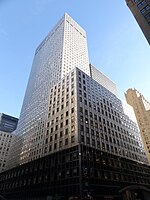Cloud Club
1930 establishments in New York City1979 disestablishments in New York (state)Clubs and societies in the United StatesDefunct restaurants in ManhattanRestaurants disestablished in 1979 ... and 2 more
Restaurants established in 1930Texaco
The Cloud Club was a lunch club that occupied the 66th, 67th, and 68th floors of the Chrysler Building in New York City. At one time it was the highest lunch club in the world. It opened in 1930 and closed in 1979.
Excerpt from the Wikipedia article Cloud Club (License: CC BY-SA 3.0, Authors).Cloud Club
East 42nd Street, New York Manhattan
Geographical coordinates (GPS) Address Nearby Places Show on map
Geographical coordinates (GPS)
| Latitude | Longitude |
|---|---|
| N 40.751666666667 ° | E -73.975277777778 ° |
Address
East 42nd Street 145
10174 New York, Manhattan
New York, United States
Open on Google Maps








